Marina Spironetti has travelled to the Alpine town of Castelrotto to attend a traditional wedding with a difference…
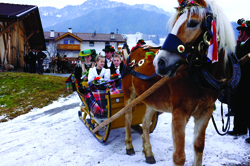 It’s a winter Sunday morning and I have a wedding to attend. It’s not going to be the usual ceremony, though. First of all, it’s a traditional one. The wedding couple, as well as all their families and guests, will all be wearing the regional costumes.
It’s a winter Sunday morning and I have a wedding to attend. It’s not going to be the usual ceremony, though. First of all, it’s a traditional one. The wedding couple, as well as all their families and guests, will all be wearing the regional costumes.
Some parts of Italy still celebrate these old-fashioned marriages with great pomp. I had already been to one in Sardinia and another near the Slovenian border. The idea that a couple wants to get married the same way people did 200 years ago has always fascinated me. This time there is a major difference, though: nobody exchanges vows here. The matrimonio contadino – or peasant wedding – is celebrated every other year in the town of Castelrotto and it is a historic reconstruction only. In other words, people get the chance to wear their beautiful traditional garments, parade through the village in horse-drawn sledges, gather on the church steps and enjoy a scrumptious lunch afterwards. Nobody sets foot into the church, no rings, nothing to sign.
The perfect wedding, if you ask me.
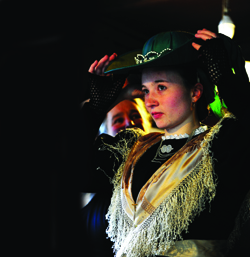 The setting is enchanting to say the least. Castelrotto is the main town in the area of the Alpe di Siusi, in the Alto Adige sub-region, nestled by mountain peaks, a dense forest, vast meadows and Alpine pastures. The area is also known as Seiser Alm in German, as everything in the northernmost Italian province is bilingual. People are more at ease speaking German than Italian over here – and if your German is as rusty as mine it won’t be much help, as theirs is a thick Tyrolean dialect, which can be difficult to understand even for German ears.
The setting is enchanting to say the least. Castelrotto is the main town in the area of the Alpe di Siusi, in the Alto Adige sub-region, nestled by mountain peaks, a dense forest, vast meadows and Alpine pastures. The area is also known as Seiser Alm in German, as everything in the northernmost Italian province is bilingual. People are more at ease speaking German than Italian over here – and if your German is as rusty as mine it won’t be much help, as theirs is a thick Tyrolean dialect, which can be difficult to understand even for German ears.
The first thing on my agenda is visiting the bride to see her getting ready. A very private and special affair, as only a few family members are allowed to attend. When I get there she is wearing a plain full-length black gown, which is the traditional costume of Castelrotto.
A bubbly lady arrives and starts taking care of her appearance. She is the tailor, who traditionally has the task of helping prepare the bride. She lays a handful of hairpins on the table and starts working on the luxuriant head of wavy hair before her, which will soon be combed into braids.
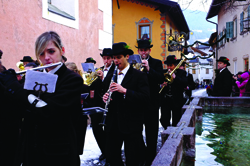 In the meantime, the father of the bride goes through the details of this beautiful 19th-century tradition. Weddings used to be celebrated in winter, as in the summer months people were busy working in the fields. The summer, on the other hand, was the time when youngsters had the chance to get to know one another – social life was limited to a few occasions, like harvest or dancing parties out in the fields at weekends. Once love struck, the groom-to-be had to ask for his beloved’s hand and then the couple had to talk to the priest, paying him a secret visit in order to avoid gossip.
In the meantime, the father of the bride goes through the details of this beautiful 19th-century tradition. Weddings used to be celebrated in winter, as in the summer months people were busy working in the fields. The summer, on the other hand, was the time when youngsters had the chance to get to know one another – social life was limited to a few occasions, like harvest or dancing parties out in the fields at weekends. Once love struck, the groom-to-be had to ask for his beloved’s hand and then the couple had to talk to the priest, paying him a secret visit in order to avoid gossip.
Considering that Castelrotto is a small town, one can easily imagine that the couple was very much in the public eye before the wedding. If any of them was known to have had previous affairs, baskets full of dung would be hung at their door as a sign of disrespect and the road to their house would be covered in sawdust to make sure everybody in the village would be aware of their crimes. A funnier tradition, on the other hand, was the one related to the stag do. Aside from plenty of food and drink, its main feature was the so-called Katzenmusik (cat music, literally), music – or rather noise – made with any possible object, which could go on until the morning after.
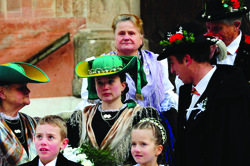 In the meantime, the bride is almost ready to go. The tailor helps her to wear the shawl – or Tücheln. It is the most important accessory of the wedding outfit, as well as the most treasured part of the Castelrotto traditional costume. As colourful as possible, made of exquisite silk and fine wool, to show the uniqueness of the lady who wears it, in contrast with the sombre plain gown. The way in which a shawl is wrapped around the shoulders requires a certain amount of skill, which is often handed down from mother to daughter. It really is an art in its own right. The tailor explains that everything must be absolutely spotless – the folds have to be carefully arranged and the shawl must stay in place from morning until night. The bride is almost ready – she needs just a few more accessories like a pair of gloves to protect her from the cold and a bright green hat.
In the meantime, the bride is almost ready to go. The tailor helps her to wear the shawl – or Tücheln. It is the most important accessory of the wedding outfit, as well as the most treasured part of the Castelrotto traditional costume. As colourful as possible, made of exquisite silk and fine wool, to show the uniqueness of the lady who wears it, in contrast with the sombre plain gown. The way in which a shawl is wrapped around the shoulders requires a certain amount of skill, which is often handed down from mother to daughter. It really is an art in its own right. The tailor explains that everything must be absolutely spotless – the folds have to be carefully arranged and the shawl must stay in place from morning until night. The bride is almost ready – she needs just a few more accessories like a pair of gloves to protect her from the cold and a bright green hat.
Talking about headgear, there is one that cannot be missed. Among the wedding guests that gather up in front of a traditional Alpine house just outside the town, ready for proceedings, a gentleman stands out. He is wearing a colourful and unusual hat, decorated with bright feathers that remind me of some exotic bird. He is the Hochzeitslader, the Master of Ceremonies, who certainly wins the award for the most interesting costume
Time to hit the road and head to the church, among snowy fields and with the outline of the Sciliar mountain as an impressive backdrop. The guests arrive on horse-drawn sledges and then line up in rows on the church steps, underneath the 88m tall church steeple, one of the highest in South Tyrol.
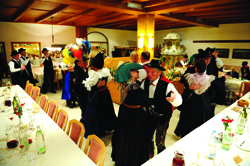 This being a purely ceremonial affair, the church part of the wedding day is skipped in favour of a more palatable traditional wedding lunch. The best part comes at the very end, before the newlyweds make their way to the dance floor. A neighbour of the bride gets the Hanswurst ready. It is a hollow cake which hides a string with 12 small little dolls. A sort of fertility dance follows – the man dances in front of the bride and she has to try to catch the string.
This being a purely ceremonial affair, the church part of the wedding day is skipped in favour of a more palatable traditional wedding lunch. The best part comes at the very end, before the newlyweds make their way to the dance floor. A neighbour of the bride gets the Hanswurst ready. It is a hollow cake which hides a string with 12 small little dolls. A sort of fertility dance follows – the man dances in front of the bride and she has to try to catch the string.
According to the tradition, the number of dolls she will manage to grasp will determine the number of children the couple is going to have. Michel, the father of the bride, says his mum caught seven and that he actually had six siblings! Very accurate indeed – but for this bride it’s probably going to be slightly different as she barely knows her fake groom.
Maybe she will just have to wait for her real wedding.
